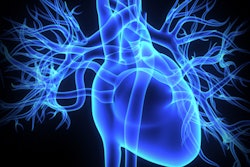
Based on up to 30 years of individual patient data for cardiac interventional procedures, German researchers have concluded more than one-third of the radiation exposure in coronary angiography procedures was unnecessary, according to a new report in the September issue of European Radiology.
Researchers from the University of Duisburg-Essen in Germany looked at 147 patients with coronary artery disease who underwent at least one invasive coronary angiography exam between 2004 and 2009. They analyzed and rated the appropriateness of hundreds of cardiac procedures according to German cardiology guidelines, and estimated the radiation exposure across entire patient histories.
Because in some cases multiple procedures were performed on a few patients, the researchers estimated that fewer than 10% of the patients received more than 60% of the total radiation, and approximately 37% of the exposure was inappropriate (Eur Radiol, September 2015, Vol. 25:9 pp. 2567-2574).
"The analysis of individual patient histories showed heterogeneous patterns of these appropriateness ratings, i.e., marked intra-individual as well as interindividual variations," wrote Birgitta M. Weltermann and colleagues. "With an increasing number of procedures per patient the percentage of those with 'low' ratings increased."
When intervention isn't helpful
Percutaneous coronary interventions have been shown to unequivocally benefit patients with acute coronary syndromes. However, such interventions are not helpful in patients with chronic stable coronary disease.
Available guidelines specifically discourage the use of invasive angiography without evidence of ischemia, but patient records reveal guidelines fairly often fail to translate into clinical practice, the authors wrote. Meanwhile, data from studies around the world reveal large discrepancies in mortality rates, even in countries with similar procedure rates. Long-term data are rare, making this study unique, the team wrote.
To get a better idea of practice patterns and outcomes, the authors performed an exploratory study in a facility with medical records dating back more than 30 years. They analyzed long-term histories of patients with known or suspected coronary artery disease.
They looked at every procedure performed on each patient, the estimated appropriateness based on 2003 and 2004 German Cardiac Society guidelines (high, intermediate, low, or none), and the estimated radiation exposure for each patient based on typical exposures at the time of the exam. Included in the analysis were patient characteristics such as age, gender, and socioeconomic status, as well as insurance coverage, risk factors, and the patient's history of cardiac care, plus dates for interventions, and diseases discovered as well as the clinicians' recommendations.
"The study was performed in Germany, which is known to have high catheterization rates yet without additional benefit for CAD patients' survival rates," Weltermann and colleagues wrote.
Several procedures per patient
Patients underwent an average of three procedures, with a wide range from one to 19 procedures per individual within up to 27 years, the authors wrote. Nearly 30% of these procedures were rated as "low appropriateness" after the fact, they noted.
In all, 147 patients had undergone at least one coronary angiography procedure during the five-year period. Most patients (72.8% n = 107) were male, and 85% (n = 126) were insured in a public sickness fund.
Looking at individual exams, 441 total procedures were recommended: 226 angiographies (51.3%) and 210 percutaneous cardiac interventions (47.6%) were performed. Eighty-five patients (57.8%) had more than one procedure, the authors wrote. The patient's average age at the first angiography exam was 63 years, and the first procedure was performed in 1981, the authors wrote.
Risk factors for cardiovascular disease were common in the cohort, and heart medications were frequently prescribed. In the later years of the study, the most common medications were statins (83% of patients), platelet inhibitors (81.6%), angiotensin-converting enzyme inhibitors 74.8%), and beta-blockers at 73.5%, the study team wrote.
Were the procedures appropriate for the indications? It depended on the order of the procedure, according to the authors.
An analysis of individual patient histories showed heterogeneous patterns of appropriateness ratings. And the more procedures a patient had, the higher number of inappropriate procedures were found. So while 92.5% of the first angiographies were rated highly appropriate, just 61.5% of the fifth angiographies were.
"Medical radiation exposure due to inadequate justification has recently been shown to be a significant problem," Weltermann and colleagues wrote. "While CT may be the primary modality involved, it is obvious that angiography and intervention often mean even higher exposure."
Rating risk for inappropriate exams
Analysis of the data showed a number of predictors for having at least one procedure with a low appropriateness rating, with all of the following statistically significant:
- Low versus high appropriateness rating (61.5% versus 43.2%)
- Being younger than 64 at the time of the first procedure (61.5% versus 43.2%)
- History of bypass surgery (23.1% versus 7.4%)
- Having one or more adverse events (26.9% versus 7.4%)
- History of coronary bypass stenosis (17.3% versus 2.1%)
- Having the first procedure in a tertiary cardiac care center (34.6% versus 7.4%).
Factors that were not statistically significant indicators a patient would receive an inappropriate procedure were gender, diabetes status, renal insufficiency, number of coronary vessels involved, and ejection fraction, the group reported.
As for radiation dose, specific dose information wasn't available, so dose was extrapolated based on typical procedure doses reported in the literature at the time of the exam.
"Our data suggest that a considerable fraction (best guess 37%) of the total radiation exposure of coronary patients might have been avoidable in the investigated patient population," the team wrote. "We showed that less than 10% of the patient population, namely those with eight and more coronary procedures, received nearly 60% of the potentially unnecessary radiation exposure, while the remaining majority of the cardiac patients received mainly procedures with 'high' appropriateness."
For future studies, it would be useful to apply such a patient-specific strategy in larger populations, the group wrote.
"When caring for patients, physicians act wisely if they pay specific attention to patients undergoing serial interventional procedures," Weltermann et al concluded.



















